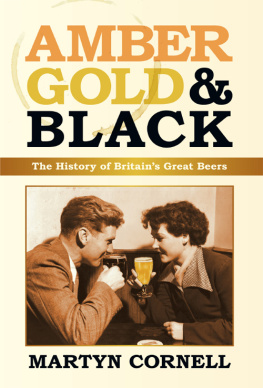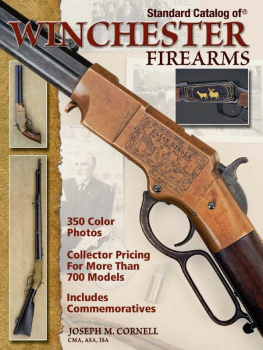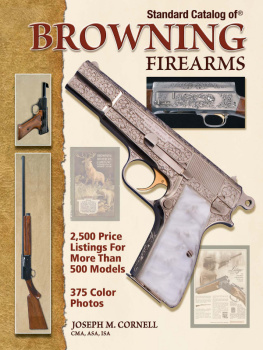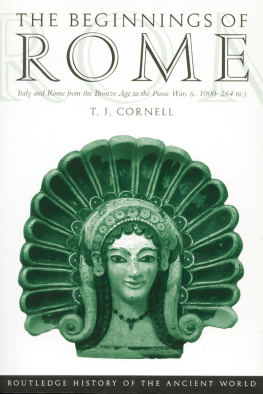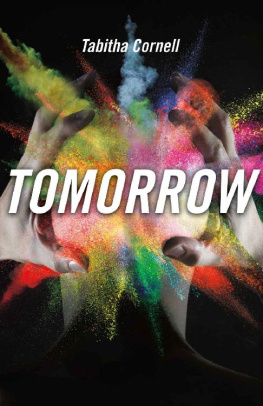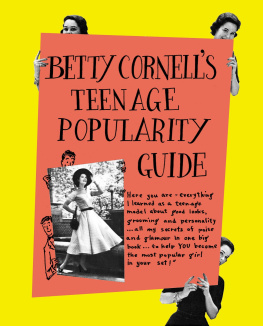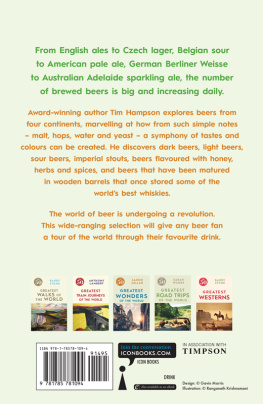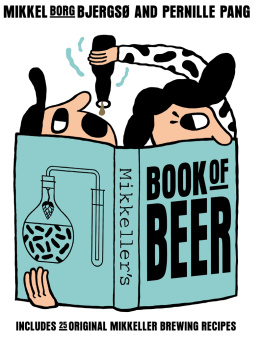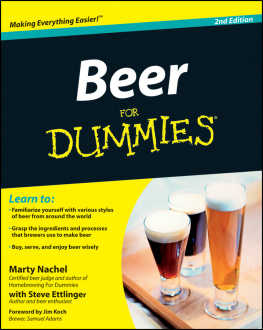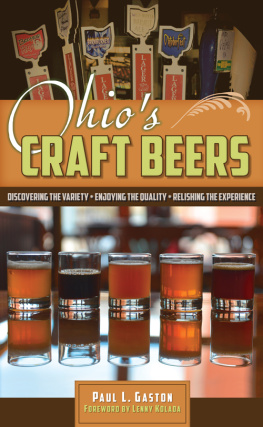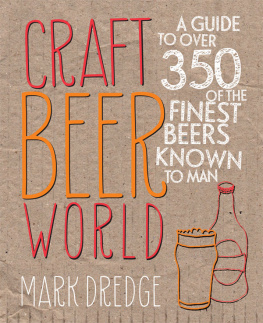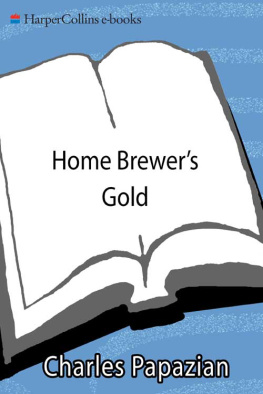AMBER
GOLD&
BLACK
AMBER
GOLD&
BLACK
The History of Britains Great Beers
MARTYN CORNELL

To Arthur Harry Cornell (19221990)
and Herbert Charles Bert Cornell (19262000)
My mentors in beer
Many thanks to Fuller, Smith & Turner of Chiswick, London and Harvey & Sons of Lewes, Sussex, without whose help this book would not have appeared.
First published 2010
The History Press
The Mill, Brimscombe Port
Stroud, Gloucestershire, GL5 2QG
www.thehistorypress.co.uk
This ebook edition first published in 2011
All rights reserved
Martyn Cornell, 2010, 2011
The right of Martyn Cornell, to be identified as the Author of this work has been asserted in accordance with the Copyrights, Designs and Patents Act 1988.
This ebook is copyright material and must not be copied, reproduced, transferred, distributed, leased, licensed or publicly performed or used in any way except as specifically permitted in writing by the publishers, as allowed under the terms and conditions under which it was purchased or as strictly permitted by applicable copyright law. Any unauthorised distribution or use of this text may be a direct infringement of the authors and publishers rights, and those responsible may be liable in law accordingly.
EPUB ISBN 978 0 7524 7594 3
MOBI ISBN 978 0 7524 7593 6
Original typesetting by The History Press
CONTENTS
INTRODUCTION
Britain is one of the worlds greatest brewing nations: a fact the British themselves often seem to be unaware of. We need to be much more proud of what we have given ourselves and the world: beautiful, refreshing hoppy bitters and IPAs, golden summer ales for hot days in the garden, heady, rich barley wines, unctuous winter warmers, cheering, sociable, conversation-encouraging milds, creamy, reviving black porters and hearty, filling stouts, barley wines and old ales for sipping and relaxing, beers that go with food of all sorts and beers that can be enjoyed on their own, beer styles born in these islands and now appreciated and brewed from San Francisco to Singapore, from St Petersburg to Sydney.
This book is a celebration of the depths of British beer, a look at the roots of the styles we enjoy today, as well as those ales and beers we have lost; a study into how the liquids that fill our beer glasses, amber, gold and black, developed over the years and a look forward to some of the new styles of beer being developed in Britain in the twenty-first century, such as ales aged in casks that once contained whisky or rum.
Astonishingly, despite a greatly increased interest in beer as a subject in Britain over the past thirty or so years, this is the first book devoted solely to looking at the unique history of the different styles of beer produced in Britain; more world-conquering styles, it might be suggested, than any other nation has managed.
It may be a good thing that Britons would rather be down the pub enjoying their beer with friends than sitting on their own at home reading about it. But I hope that learning more about, for example, how bitter grew and developed out of the Victorian middle class desire for the then newly fashionable pale ales once exclusively enjoyed by the gentry; how the demand by the street and river porters of London for a filling, strength-giving beer to help them get through the working day eventually gave us a style that, in Irish arms, circled the globe; how a style developed for Baltic aristocrats became Burton Ale, one of the most popular beers in Britain until a couple of generations ago and now almost forgotten; how beers such as Broom Ale, Mum and West Country White Ale once thrived and then vanished; how the huge boom in brewery numbers in Britain in the past thirty years, with more than 700 microbreweries now in operation, has helped bring in new styles such as golden ale and wood-aged beers, and even how nineteenth-century British brewers helped inspire the development of modern lager, all may add to the enjoyment of your beer-drinking experience, wherever you are doing it and encourage you to appreciate the marvellous drink, beer, more and to explore further its many offerings.
In addition, detailing the long histories behind Britains beers may go some way to restoring respect for the countrys national drink. While Thomas Hardy could write in The Trumpet Major of Dorchester beer that The masses worshipped it; the minor gentry loved it more than wine, and by the most illustrious county families it was not despised, today beer is seldom given the position at the heart of British gastronomic life that it deserves. British food grew and developed alongside beer and the two complement each other, just as French or Italian food is complemented by wine. Roast beef is fantastic with pale ale, porter is terrific with steak or lamb, stout is great with pork and chicken or spicy foods and any British cheese has its companion beer, from Cheddar and bitter to Stilton and barley wine and desserts go just as well with beer too, as anyone who has tried apricot clafoutis with IPA, strong ale with plum pudding or chocolate stout with good vanilla ice cream will affirm.
In short, this book is a celebration of British beer in all its many beautiful shades and inspiring flavours. Good drinking!
1
BITTER
Im getting rather hoarse, I fear,
After so much reciting:
So, if you dont object, my dear,
Well try a glass of bitter beer
I think it looks inviting.
Phantasmagoria, Lewis Carroll, 1869
The pint is one of the icons of Britain and to most people today the beer in that iconic pint must be bitter, the amber-brown, malty beer strongly flavoured with hops that everyone imagines in the hands of Britons as they drink at an old oak table in a thatched-roof country pub, or while they enjoy an evening song around a battered piano in a cheery street-corner boozer. Except that bitter, while undoubtedly one of Britains greatest contributions to the world of beer, only became the countrys favourite drink in the early 1960s.
The origins of bitter, especially considering its popularity, are surprisingly obscure. There does not appear to have been a beer called bitter much before the time that Queen Victoria came to the throne in 1837. What seems to have happened is that the name bitter came about because drinkers wanted to differentiate the well-hopped, matured pale ales, which were gaining a place in brewers portfolios around the country by the start of the 1840s, from the sweeter, less-aged and generally less hopped mild ales that, until then, had been almost the only alternative to porter and stout for most drinkers for more than a century.
Porter, which was slowly losing its enormous popularity when William IV died, after 100 years as the nations top seller, was always called beer. Even in the 1930s if you ordered simply beer in certain pubs in mean neighbourhoods you were likely to be served porter, no further questions asked. If you didnt want porter you asked for ale. What you got for ale was young, mild, sweet and, at that time around 1840, pale as well, being made generally entirely from pale malt. What to call it, then, when a new type of beer, pale, but tart, aged and hoppy, began appearing in pubs?
Brewers named, and continued to name, the new hoppier drink pale ale. The London brewer Whitbread listed pale ale, mild ale, stout and Burton as the four chief types of beer today, and many of the beers we think of today as bitters are still called pale ales by their makers. Truman, Hanbury and Buxton brewed beers at its Burton upon Trent brewery called PA1 and PA2 for pale ales one and two. The first was its strong Ben Truman bitter, the second its standard bitter. When Young & Co.s Ram brewery in Wandsworth, South London, closed in 2006, it still sent its ordinary bitter out in casks labelled PA for Pale Ale, exactly the same as when it was first brewed in 1864, while casks of its special bitter are marked SPA. In 1952 Marstons of Burton gave its best pale ale the name Pedigree Pale Ale, while London Pride was originally advertised by its brewer, Fuller, Smith & Turner, as London Pride pale ale; today no drinker would call Pedigree or Pride anything except brands of bitter.

